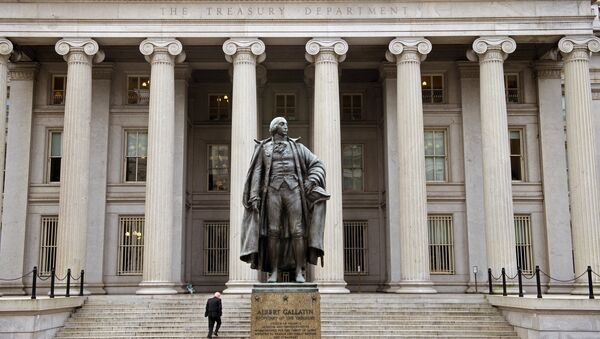According to newly released data by the US Department of Treasury, Russia slashed investments in US government debt by $1.2 billion to $10.848 billion in June 2019.
While it remains unclear who is buying its Treasury holdings, Moscow, once a top investor, has been steadily dumping US bonds for months now amid efforts to boost its gold reserves.
US Treasury bonds: risk-free investing?
US Treasury Securities, marketable, fixed-interest government debt issued by the US Treasury Department, are used to finance a country's public debt.
Treasuries, which technically include bills, notes, and bonds, are all backed by "the full faith and credit of the US government", and can all be purchased either directly from the department or via a broker. The major difference among the three varieties is the time investors need to wait to pay the principal: for instance, Treasury bills mature in one year or less; Treasury notes are issued with maturities from two to ten years, while bonds are long-term investments that have maturities of 10 to 30 years from their issue date.
Trading allows the US government to receive additional funds to finance government spending in the event of a large budget deficit - $119.7 billion in July 2019. The total US budget deficit for the 2018 fiscal year amounted to $779 billion - the largest figure in six years, as multiple media outlets noted, and this year it is expected to exceed $1 trillion.
Investors, in turn, ensure the safety of reserve funds. The yield on US securities is relatively low, but since the United States is one of the world's largest economies, this allows it to count on a guaranteed refund under any conditions.
How many bonds did Russia sell?
Russian investments in US bonds peaked in 2010 - at the time they exceeded $170 billion, but have since significantly plummeted as the government moved to diversify its international reserves. At the beginning of 2018, they dropped below $100 billion - to $96.9 billion, while in April investments decreased to $48.7 billion, and in May were cut to $14.9 billion. As of June, Russia's US Treasury holdings amount to $10.85 billion - the lowest figure since the spring of 2007.
Why do countries invest in US public debt?
Public debt, normally in the form of bonds, is often deemed a low-risk investment, whether countries are purchasing government bonds or those issued by a company. One of the biggest pros of bonds is that it's typically a very safe investment, while the biggest downside is a somewhat low yield.
As per usual, the top five major holders of US Treasury bonds in June are led by Japan with investments worth $1.122 trillion and China with $1.112 trillion, even though Beijing dumped bonds earlier this year against the backdrop of a trade war with Washington, having reduced its holdings from $1.171 trillion in June 2018.
The UK, which invested $341.1 billion in American securities, holds third place, while Brazil and Ireland close the top-five list with $311.7 billion and $262.1 billion, respectively.
Why is Russia getting rid of its US bond holdings?
Russia has been buying large amounts of gold as it continues to sell off US Treasury bonds in a move that's motivated by a decision to diversify international reserves, Head of the Central Bank of Russia Elvira Nabiullina said. She has, likewise, explained that these actions mitigate external economic and political risks for Moscow, including sanctions or a potential asset freeze by the US authorities.
Any alternatives?
Russia is steadily increasing its gold reserves, from $60.2 billion at the beginning of 2017 to $101.9 billion in July 2019 amid a clear de-dollarisation drive. In light of its efforts, Bloomberg made an assumption last week that Russian gold and foreign exchange reserves could exceed the reserves of Saudi Arabia for the first time in eight years, which would allow Moscow to occupy fourth place in international rankings. Meanwhile, government bonds in euros and the Japanese yen remain an option as well.



